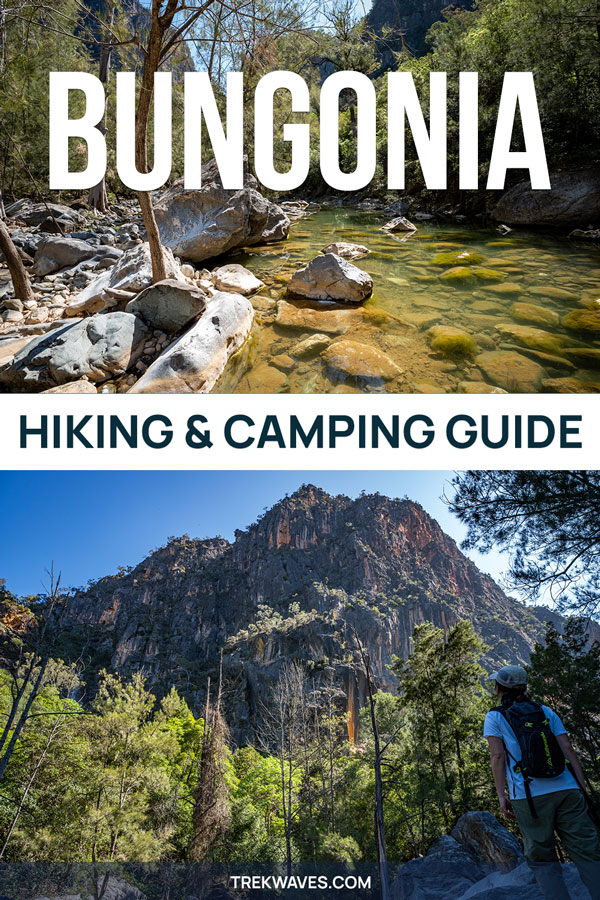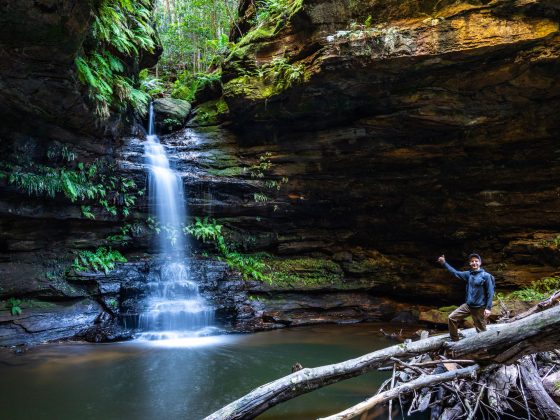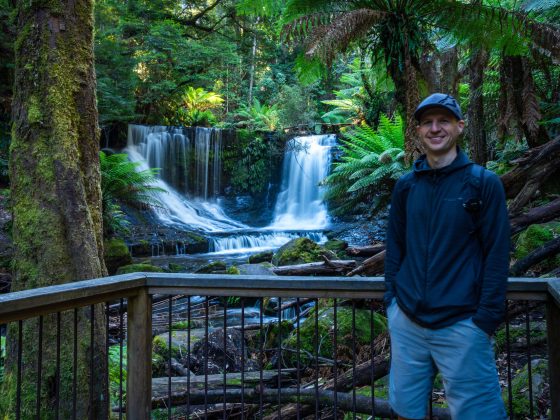Located only 2 hours drive from Sydney, Bungonia National Park is close enough for a quick escape, yet remote enough to deliver an authentic sense of adventure.
After hearing numerous stories about its breathtaking scenery, we agreed that a weekend camping trip was the perfect way to experience this extraordinary place in New South Wales.
With scenic lookouts, dramatic gorges, striking limestone caves, and trails for every skill level—from gentle strolls to the demanding Red Track—Bungonia offers incredible opportunities for hiking, camping, and caving.
Let’s dive into what makes Bungonia National Park a must-visit for every nature enthusiast.
Bungonia Campground
Bungonia Campground is an ideal base for exploring the park. It offers comfortable facilities in a natural bushland setting, including hot showers, a camp kitchen, picnic tables and BBQs.
The campground features 71 unmarked campsites suited to tents, camper trailers, and caravans.
The campground’s large layout means that, even on weekends, there should be plenty of private, quiet spots for those looking to enjoy some solitude.
Wildlife sightings are common here, with kangaroos, possums, goannas, and even occasional koalas adding to the park’s charm.
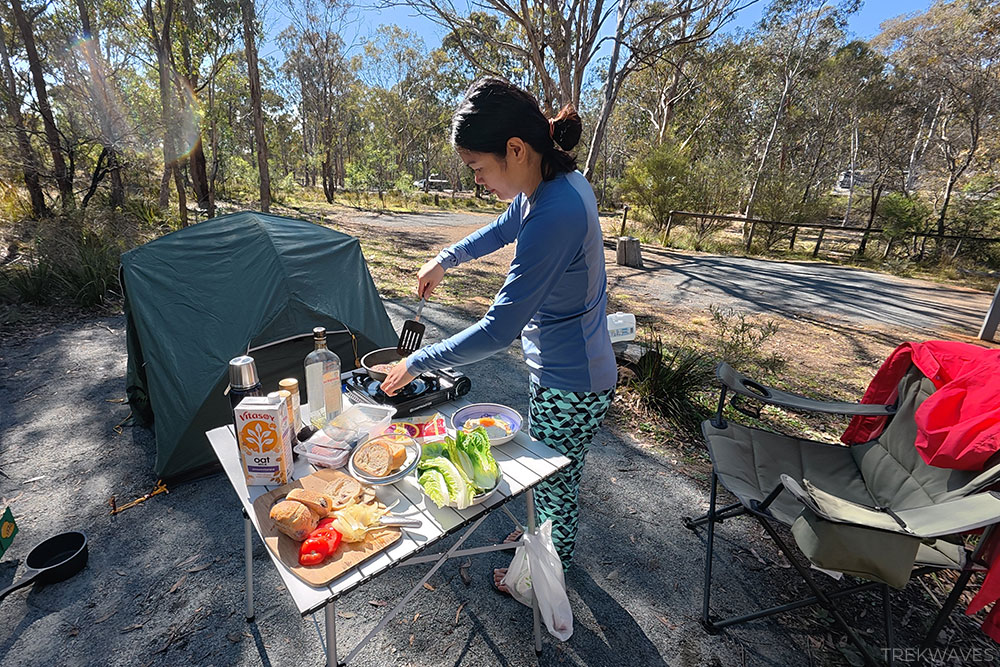
Camping Details
- Facilities: Hot showers, toilets, picnic tables, barbecue facilities and a camp kitchen.
- Fees: $8 per vehicle per day (separate from camping fees).
- Pet policy: Pets and domestic animals are not permitted.
As of writing, campfires are prohibited at Bungonia campground. Should this policy be updated, you’ll need to bring your own firewood for any campfire, as gathering wood in the park is prohibited for conservation reasons.
Be aware that mobile reception is limited, so pre-download any maps you may need.
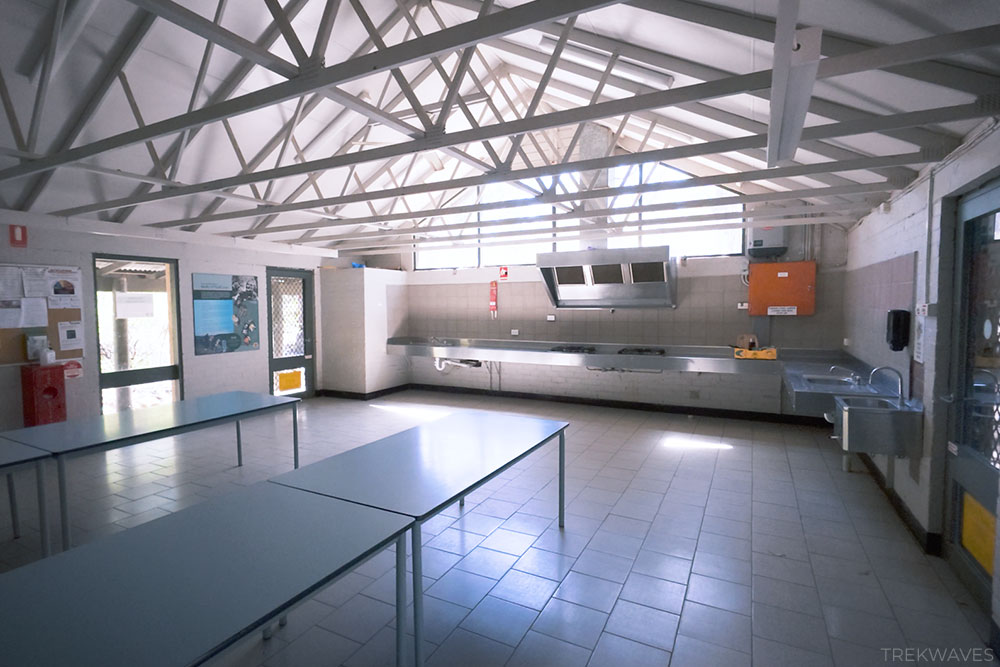
With the campground’s remote location and lack of nearby shops, it’s wise to pack enough food and water.
While filtered water is available, I’d recommend bringing your own drinking supply—when we used one of the stations, the water appeared slightly yellow with some sediment.
The campground’s central location and amenities make it an ideal starting point for exploring the nearby trails and attractions.
All campground bookings can be done on this website.

Bungonia’s Geology
The striking geology of Bungonia National Park dates back hundreds of millions of years, shaped by marine deposition, volcanic activity and tectonic uplift.
Around 400 million years ago, the region was submerged under a shallow sea where sediments and marine life contributed to extensive limestone formations.
This limestone formed from marine deposits in an ancient sea, with layers building up from the remains of coral reefs, shells, and other organisms.
Eventually, volcanic eruptions covered parts of these layers in ash, altering and solidifying them through immense heat and pressure.
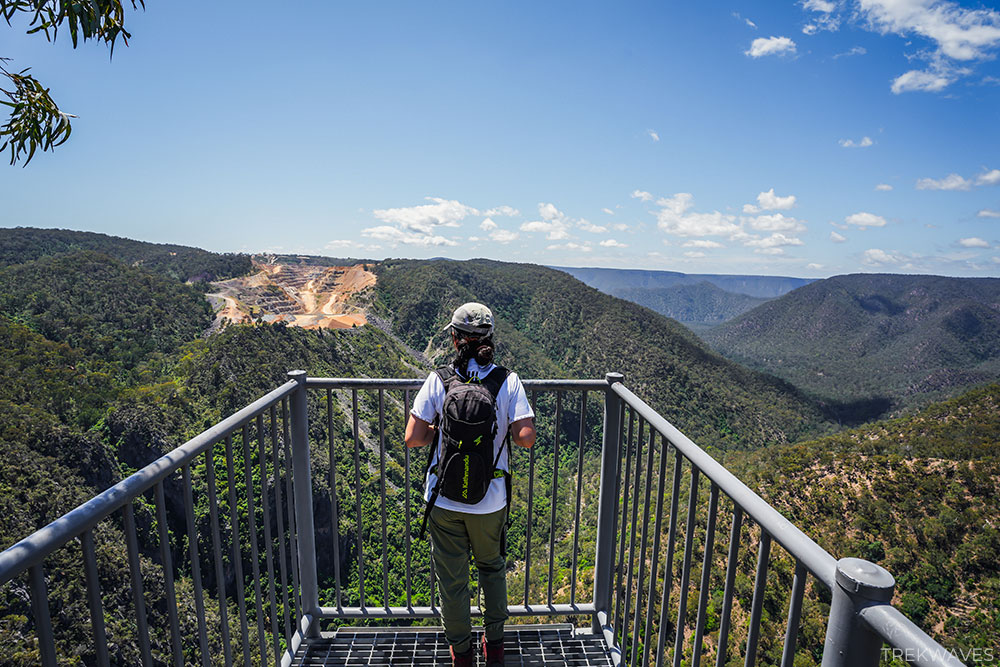
Later tectonic forces uplifted the seabed, exposing limestone cliffs, canyons, and caves, including notable sites like the Fossil Wall, where ancient marine fossils are still visible.
Bungonia’s mix of limestone and volcanic rock formations makes it a fascinating destination for geology enthusiasts.
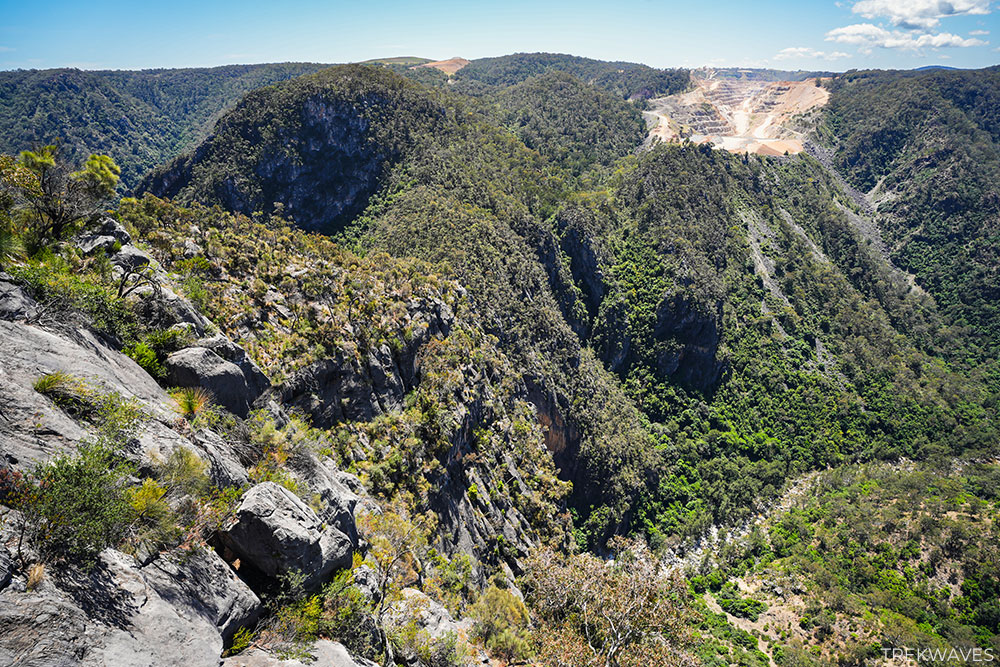
With a depth of up to 300 meters, Bungonia Gorge is a stunning example of limestone erosion, displaying its significant geological history.
Bungonia’s Best Hikes
Bungonia National Park is famous for its trails that range from family-friendly walks to challenging treks through limestone gorges.
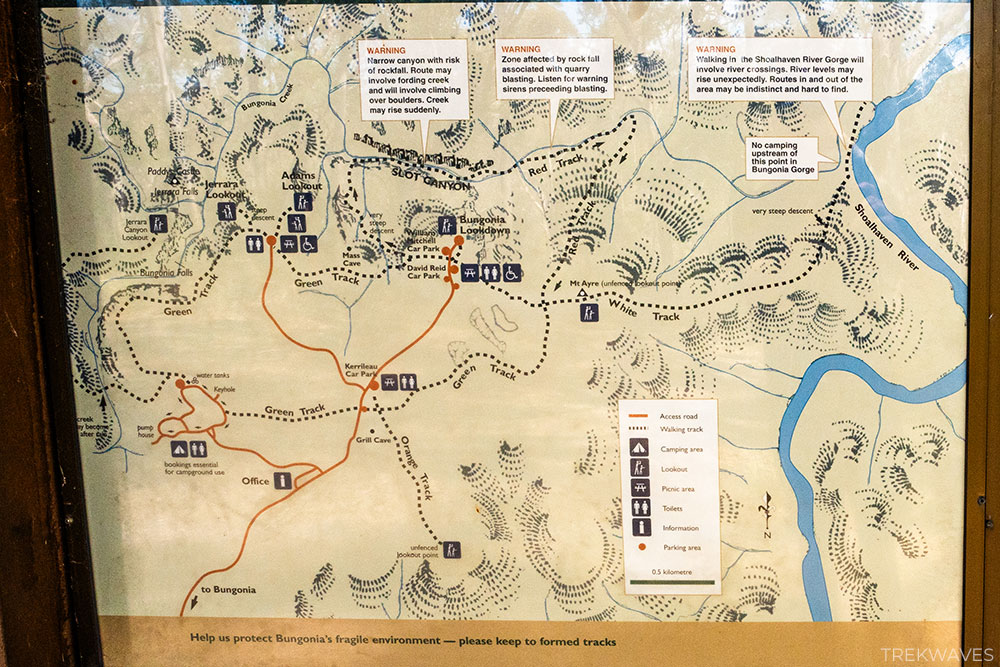
Here’s a breakdown of the main hiking tracks:
1. Red Track
The Red Track is the most challenging trail in Bungonia, descending into Bungonia Slot Canyon and Bungonia Gorge through a vast field of massive boulders.

Here are the trail details:
- Distance: 5.8 km loop
- Elevation Gain: 535m
- Time Required: At least half day
- Difficulty: Grade 5 (very difficult and steep)
- Navigation: Requires high-level fitness, navigation skills, and experience with off-track hiking. There are minimal directional markers.
- Trail Conditions: Rough terrain with loose rocks and slippery surfaces in wet weather.
- Safety Precautions: Register in the logbook, notify an emergency contact, and avoid hiking if temperatures exceed 30°C or heavy rain is expected due to the risk of flash floods.
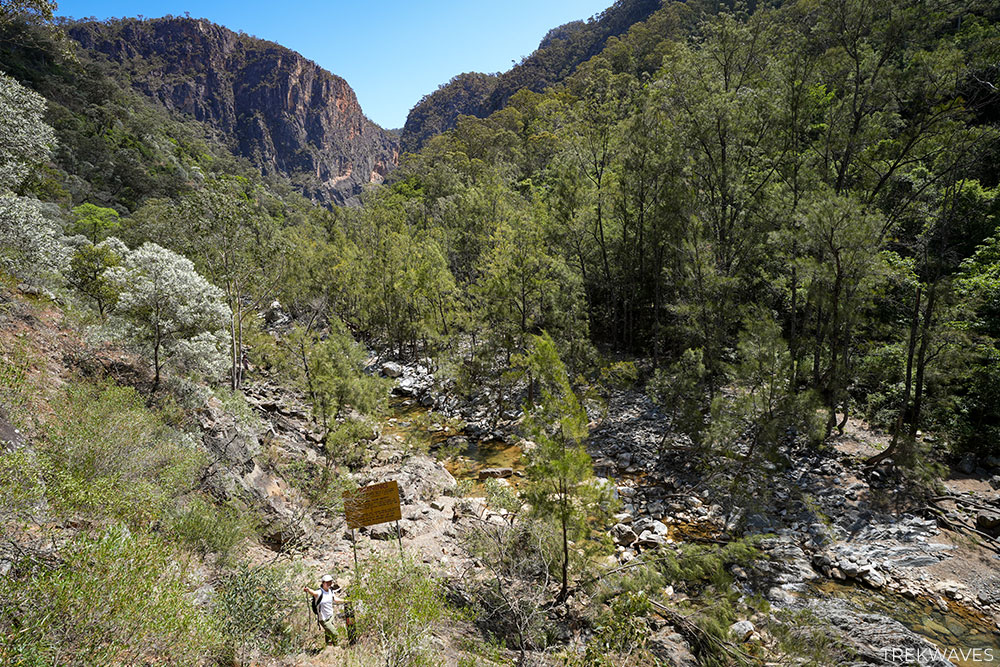
Trail Highlights:
For those seeking an extreme adventure, the Red Track offers a steep, remote trail with minimal signage, difficult terrain, and no mobile reception in the gorge—so preparation is essential.
The track begins at David Reid Car Park, which also serves as the start of the short trail to Bungonia Lookdown—a viewpoint that offers breathtaking views of the gorge below.

We started this trail on the second day around midday. However, when we faced the expansive boulder field, it became clear that we wouldn’t have enough daylight to proceed safely, and we decided to turn back.
Although we didn’t complete the full loop, descending to the beautiful Bungonia Creek and walking along it while admiring the impressive cliff walls of Bungonia Gorge was truly unforgettable.
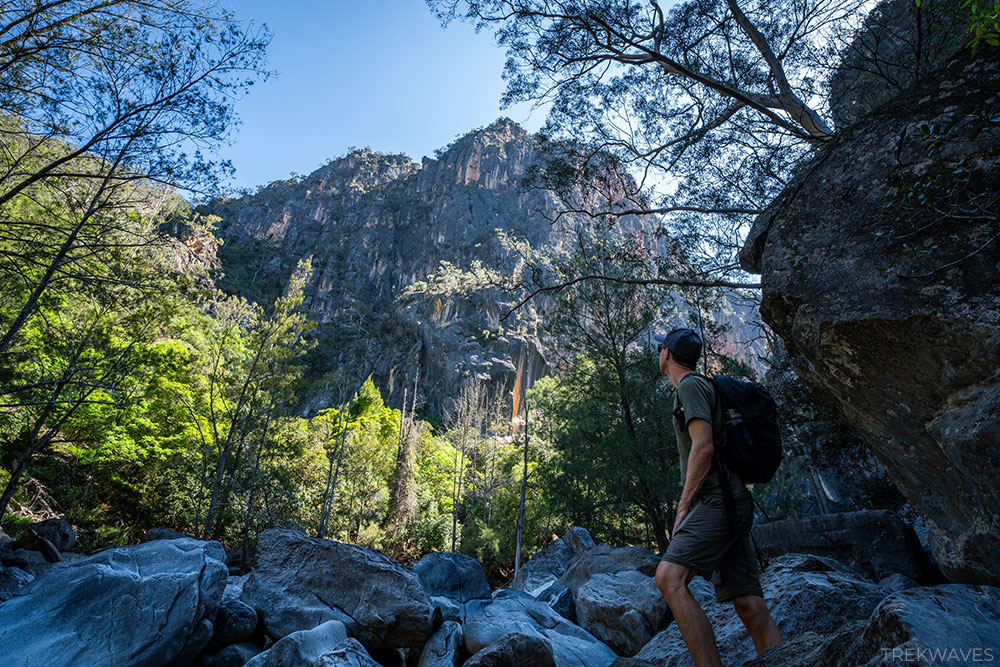
One thing to keep in mind is that the recommended direction for this trail is clockwise.
We actually went counterclockwise, which could explain our trouble finding the correct path through the boulder field. So, if you’re planning to hike the Red Track, consider following the clockwise route.
2. Green Track
This circuit trail is easily accessible from Bungonia Campground for those staying there, providing a pathway to most of the park’s best lookout points.
The trail also offers optional side trips to popular spots like the Fossil Cave and Mass Cave along the way.
These caves are worth visiting but may have restricted access; it’s a good idea to check with the visitor center for any updates on entry limitations.

Here are the trail details:
- Distance: +6 km loop
- Elevation Gain: 335m
- Time Required: Half day
- Difficulty: Easy to Moderate
This circuit trail is ideal for those wanting to experience Bungonia’s natural beauty without an intense workout, making it an excellent introduction to the park.
For those looking to extend the adventure, the Green Track offers access to other popular viewpoints, including Mount Ayre Lookout along the White Track and the scenic lookdown on the Orange Track.

3. Yellow Track
The Yellow Track is a moderately challenging trail that starts from Bungonia Campground and crosses Bungonia Creek (unbridged) leading north to Jerrara Canyon Lookout.
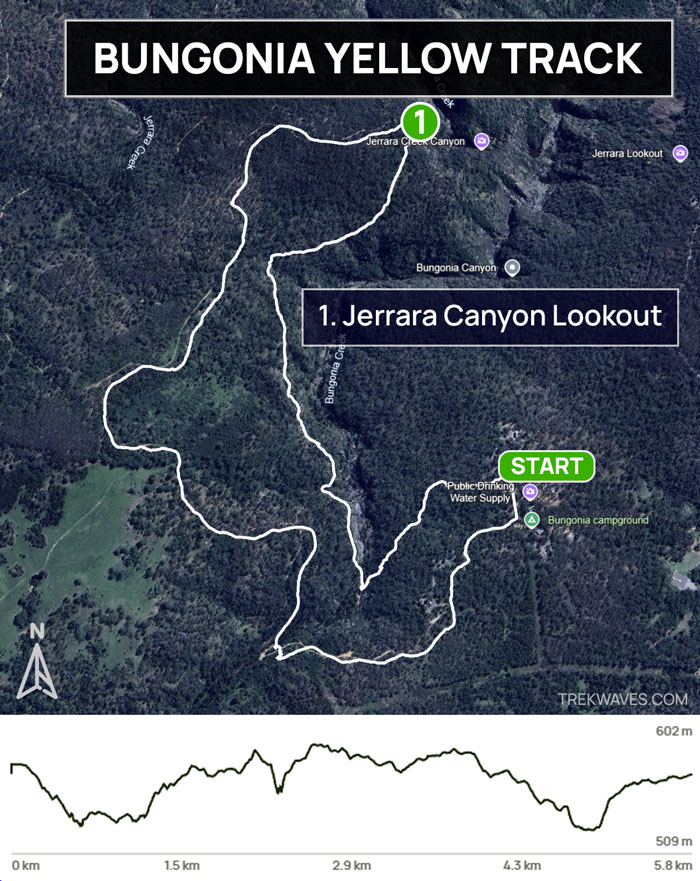
Here are the trail details:
- Distance: 4.4km return (or 5.8 km loop)
- Elevation Gain: +150m
- Time Required: Couple of hours
- Difficulty: Moderate
You can choose to hike this as a 4.4 km out-and-back route from the campground to the lookout, or make it a 5.8 km loop by circling back along the Jerrara-Falls Trail.
4. White Track
Starting at the David Reid Car Park, the White Track is a challenging 6.3 km return trail that takes you down to the banks of the Shoalhaven River.
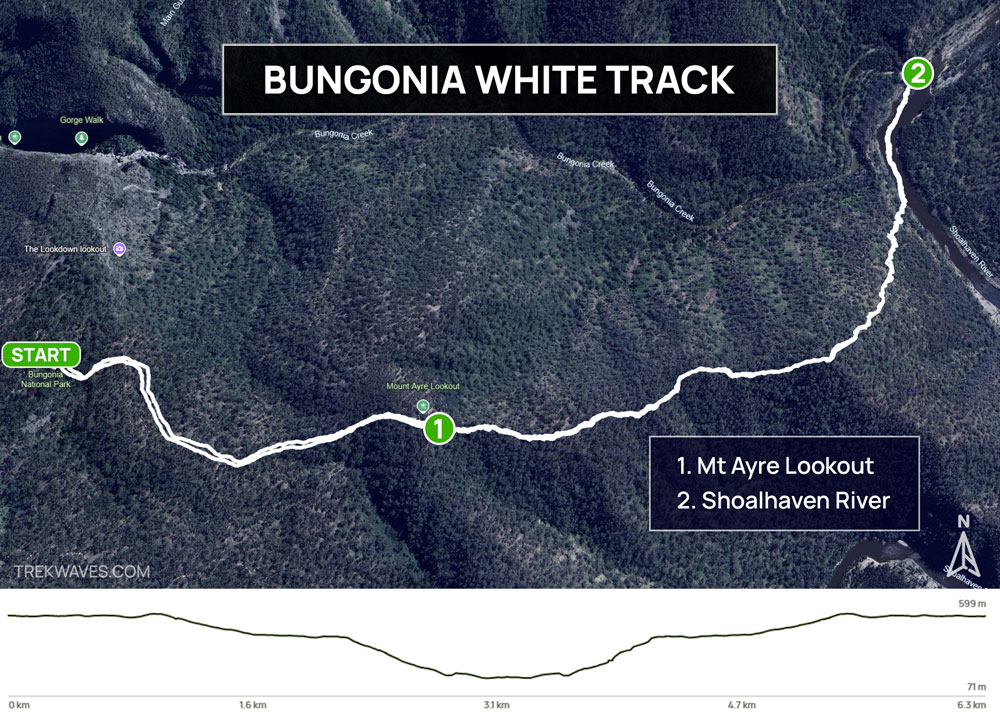
Here are the trail details:
- Distance: 6.3km return
- Elevation Gain: 496m
- Time Required: Half day
- Difficulty: Hard
The path leading to Mt Ayre Lookout is a straightforward 2km return trek, offering breathtaking views of the Shoalhaven Gorge, which lies 300m below.
Those wishing to explore further should brace themselves for a strenuous and steep descent toward the Shoalhaven River, which is not recommended for inexperienced hikers.
5. Orange Track
At 2.2 km, the Orange Track is a shorter and more accessible trail, perfect for beginners or anyone looking for an easy hike.
With mostly flat terrain, this trail provides a laid-back nature walk with only slight elevation changes.

Here are the trail details:
- Distance: 2.2km return
- Elevation Gain: 47m
- Time Required: 1 hour
- Difficulty: Easy
The Orange Track may not have the sweeping gorge views of the Yellow and Red Tracks, but it offers a serene walk through native flora, concluding with a beautiful viewpoint.

Bungonia’s Bats
Bungonia is home to two species of insectivorous bats, including the vulnerable large bent-wing bat and eastern horseshoe bat.
These bats play a crucial role in the ecosystem by controlling insect populations, and their life cycle is carefully managed within the park’s caves.
- Annual life cycle: Bats gather in large numbers in Drum and Grill caves for breeding and hibernation. Each season, the park takes measures to protect their roosting habitats.
- Seasonal closures: Main caves are closed during sensitive periods, such as breeding and winter hibernation, to prevent disturbance.
- Visitor guidelines: Avoid entering caves marked as off-limits to minimise stress on the bat populations and reduce the risk of spreading diseases.
Their conservation efforts highlight the importance of preserving natural habitats and respecting wildlife.

Final Thoughts
This was our first visit to Bungonia National Park, and we’re already looking forward to returning for a deeper exploration of this remarkable place.
The campground is comfortable, and the park provides a wonderful combination of trails for every level, beautiful lookouts, and intriguing wildlife, so you’re bound to have an amazing experience just as we did.
Found It Helpful? Pin It for Later!
